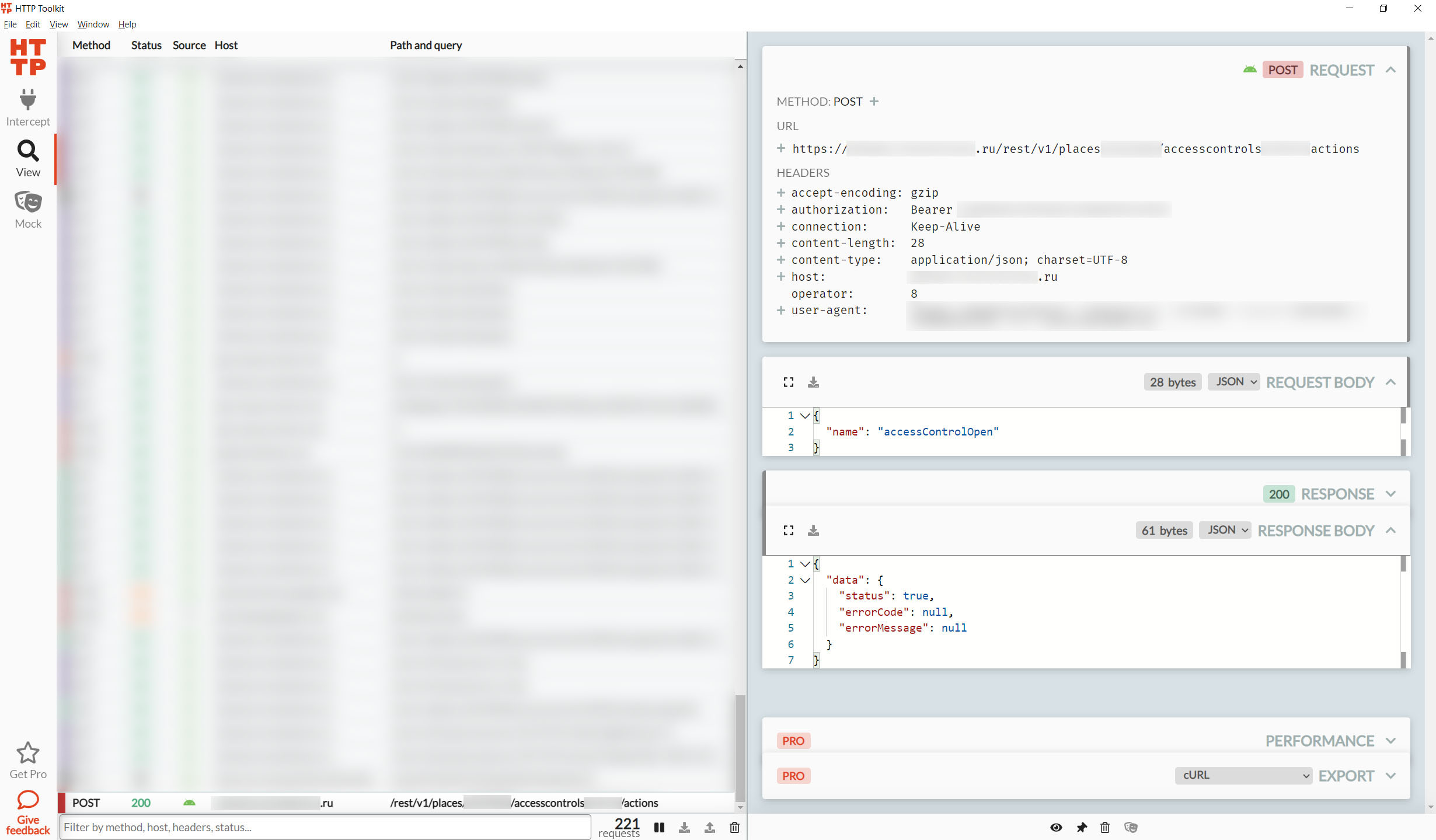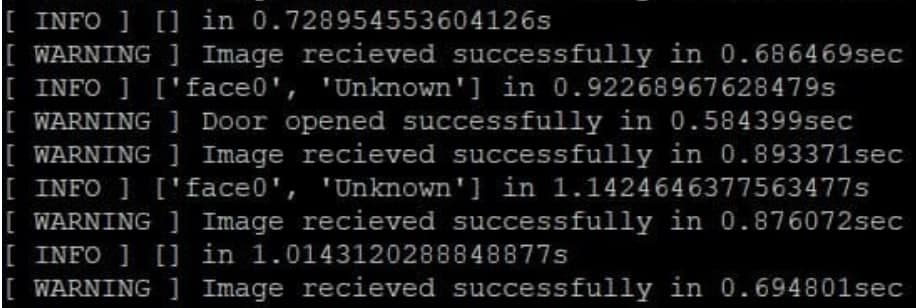Friday's work day at a distance was already coming to an end, when there was a knock on the door to announce the installation of a new intercom. Upon learning that the new intercom has a mobile application that allows you to answer calls without being at home, I became interested and immediately downloaded it to my phone. After logging in, I discovered an interesting feature of this application - even without an active call to my apartment, I could look into the intercom camera and open the door at any time. "Yes, this is online ARI at the entrance door!" - clicked in my head. The fate of the coming weekend was sealed.
Video demonstration at the end of the article.

Disclaimer
. , - — .
API
, , . - — , . lkit — , http(s) Android .
— Android- Certificate authority , . , Android 7 .
root , Android, Android Studio. ADB , Certificate pinning .

, — , .

:
: POST
/rest/v1/places/{place_id}/accesscontrols/{control_id}/actions
JSON-{"name": "accessControlOpen"}
() : GET
/rest/v1/places/{place_id}/accesscontrols/{control_id}/videosnapshots
: GET
/rest/v1/forpost/cameras/{camera_id}/video?LightStream=0
HTTP Authorization — , . Advanced REST Client, , Authorization API , , .
Python requests
, :
HEADERS = {"Authorization": "Bearer ###"}
ACTION_URL = "https://###.ru/rest/v1/places/###/accesscontrols/###/"
VIDEO_URL = "https://###.ru/rest/v1/forpost/cameras/###/video?LightStream=0"
def get_image():
result = requests.get(f'{ACTION_URL}/videosnapshots', headers=HEADERS)
if result.status_code != 200:
logging.error(f"Failed to get an image with status code {result.status_code}")
return None
logging.warning(f"Image received successfully in {result.elapsed.total_seconds()}sec")
return result.content
def open_door():
result = requests.post(
f'{ACTION_URL}/actions', headers=HEADERS, json={"name": "accessControlOpen"})
if result.status_code != 200:
logging.error(f"Failed to open the door with status code {result.status_code}")
return False
logging.warning(f"Door opened successfully in {result.elapsed.total_seconds()}sec")
return True
def get_videostream_link():
result = requests.get(VIDEO_URL, headers=HEADERS)
if result.status_code != 200:
logging.error(f"Failed to get stream link with status code {result.status_code}")
return False
logging.warning(f"Stream link received successfully in {result.elapsed.total_seconds()}sec")
return result.json()['data']['URL']
, — Intel(R) Xeon(R) CPU E5-2650L v3 @ 1.80GHz
, 1GB 0 GPU. , , .
, . OpenVINO Toolkit — Intel, CPU.
Interactive Face Recognition Demo — , . , - 2020.3, pip 2021.1. OpenVINO .
, . ( ), , , :
class ImageProcessor:
def __init__(self):
self.frame_processor = FrameProcessor()
def process(self, image):
detections = self.frame_processor.process(image)
labels = []
for roi, landmarks, identity in zip(*detections):
label = self.frame_processor.face_identifier.get_identity_label(
identity.id)
labels.append(label)
return labels
. , get_image()
.
100 runs on an image with known face:
Total time: 7.356s
Time per frame: 0.007s
FPS: 135.944
100 runs on an image without faces:
Total time: 2.985s
Time per frame: 0.003s
FPS: 334.962
, .
1 FPS:
, , . , MVP get_image()
.
class ImageProcessor:
# <...>
def process_single_image(self, image):
nparr = np.fromstring(image, np.uint8)
img_np = cv2.imdecode(nparr, cv2.IMREAD_COLOR)
labels = self.process(img_np)
return labels
def snapshot_based_intercom_id():
processor = ImageProcessor()
last_open_door_time = time.time()
while True:
start_time = time.time()
image = get_image()
result = processor.process_single_image(image)
logging.info(f'{result} in {time.time() - start_time}s')
# Successfull detections are "face{N}"
if any(['face' in res for res in result]):
if start_time - last_open_door_time > 5:
open_door()
with open(f'images/{start_time}_OK.jfif', 'wb') as f:
f.write(image)
last_open_door_time = start_time
, , . , .. .

! , . , — , .. API . , 0.7 0.6 , .
30 FPS:
:
vcap = cv2.VideoCapture(link) success, frame = vcap.read()
, 30 FPS. : read()
. , , , . , , 30 — , .
: vcap.set(CV_CAP_PROP_BUFFERSIZE, 0);
. , OpenCV 3.4, - , . , StackOverflow — , ( , ).
ImageProcessor
3 :
class CameraBufferCleanerThread(threading.Thread):
def __init__(self, camera, name='camera-buffer-cleaner-thread'):
self.camera = camera
self.last_frame = None
self.finished = False
super(CameraBufferCleanerThread, self).__init__(name=name)
self.start()
def run(self):
while not self.finished:
ret, self.last_frame = self.camera.read()
def __enter__(self): return self
def __exit__(self, type, value, traceback):
self.finished = True
self.join()
class ImageProcessor:
# <...>
def process_stream(self, link):
vcap = cv2.VideoCapture(link)
interval = 0.3 # ~3 FPS
with CameraBufferCleanerThread(vcap) as cam_cleaner:
while True:
frame = cam_cleaner.last_frame
if frame is not None:
yield (self.process(frame), frame)
else:
yield (None, None)
time.sleep(interval)
snapshot_based_intercom_id
:
def stream_based_intercom_id():
processor = ImageProcessor()
link = get_videostream_link()
# To notify about delays
last_time = time.time()
last_open_door_time = time.time()
for result, np_image in processor.process_stream(link):
current_time = time.time()
delta_time = current_time - last_time
if delta_time < 1:
logging.info(f'{result} in {delta_time}')
else:
logging.warning(f'{result} in {delta_time}')
last_time = current_time
if result is None:
continue
if any(['face' in res for res in result]):
if current_time - last_open_door_time > 5:
logging.warning(
f'Hey, I know you - {result[0]}! Opening the door...')
last_open_door_time = current_time
open_door()
cv2.imwrite(f'images/{current_time}_OK.jpg', np_image)
— , .

Telegram
/. .
python-telegram-bot
, callback / .
class TelegramInterface:
def __init__(self, login_whitelist, state_callback):
self.state_callback = state_callback
self.login_whitelist = login_whitelist
self.updater = Updater(
token = "###", use_context = True)
self.run()
def run(self):
dispatcher = self.updater.dispatcher
dispatcher.add_handler(CommandHandler("start", self.start))
dispatcher.add_handler(CommandHandler("run", self.run_intercom))
dispatcher.add_handler(CommandHandler("stop", self.stop_intercom))
self.updater.start_polling()
def run_intercom(self, update: Update, context: CallbackContext):
user = update.message.from_user
update.message.reply_text(
self.state_callback(True) if user.username in self.login_whitelist else 'not allowed',
reply_to_message_id=update.message.message_id)
def stop_intercom(self, update: Update, context: CallbackContext):
user = update.message.from_user
update.message.reply_text(
self.state_callback(False) if user.username in self.login_whitelist else 'not allowed',
reply_to_message_id=update.message.message_id)
def start(self, update: Update, context: CallbackContext) -> None:
update.message.reply_text('Hi!')
class TelegramBotThreadWrapper(threading.Thread):
def __init__(self, state_callback, name='telegram-bot-wrapper'):
self.whitelist = ["###", "###"]
self.state_callback = state_callback
super(TelegramBotThreadWrapper, self).__init__(name=name)
self.start()
def run(self):
self.bot = TelegramInterface(self.whitelist, self.state_callback)
intercom_id
, :
def stream_based_intercom_id_with_telegram():
processor = ImageProcessor()
loop_state_lock = threading.Lock()
loop_should_run = False
loop_should_change_state_cv = threading.Condition(loop_state_lock)
is_loop_finished = True
loop_changed_state_cv = threading.Condition(loop_state_lock)
def stream_processing_loop():
nonlocal loop_should_run
nonlocal loop_should_change_state_cv
nonlocal is_loop_finished
nonlocal loop_changed_state_cv
while True:
with loop_should_change_state_cv:
loop_should_change_state_cv.wait_for(lambda: loop_should_run)
is_loop_finished = False
loop_changed_state_cv.notify_all()
logging.warning(f'Loop is started')
link = get_videostream_link()
last_time = time.time()
last_open_door_time = time.time()
for result, np_image in processor.process_stream(link):
with loop_should_change_state_cv:
if not loop_should_run:
is_loop_finished = True
loop_changed_state_cv.notify_all()
logging.warning(f'Loop is stopped')
break
current_time = time.time()
delta_time = current_time - last_time
if delta_time < 1:
logging.info(f'{result} in {delta_time}')
else:
logging.warning(f'{result} in {delta_time}')
last_time = current_time
if result is None:
continue
if any(['face' in res for res in result]):
if current_time - last_open_door_time > 5:
logging.warning(f'Hey, I know you - {result[0]}! Opening the door...')
last_open_door_time = current_time
open_door()
cv2.imwrite(f'images/{current_time}_OK.jpg', np_image)
def state_callback(is_running):
nonlocal loop_should_run
nonlocal loop_should_change_state_cv
nonlocal is_loop_finished
nonlocal loop_changed_state_cv
with loop_should_change_state_cv:
if is_running == loop_should_run:
return "Intercom service state is not changed"
loop_should_run = is_running
if loop_should_run:
loop_should_change_state_cv.notify_all()
loop_changed_state_cv.wait_for(lambda: not is_loop_finished)
return "Intercom service is up"
else:
loop_changed_state_cv.wait_for(lambda: is_loop_finished)
return "Intercom service is down"
telegram_bot = TelegramBotThreadWrapper(state_callback)
logging.warning("Bot is ready")
stream_processing_loop()
:
Despite the possibilities that smart intercom technology brings to residents, hundreds (thousands?) Of driveway doors with cameras and microphones (yes, there is audio in the randomly received video stream!) , opening up new opportunities for privacy violations.
I would prefer that access to the video stream was provided only at the time of a call to the apartment and the ongoing three-day recording, positioned as a means of disclosing violations, was stored not on the company's servers, but directly in the intercom, with the ability to access it upon request. Or not at all.